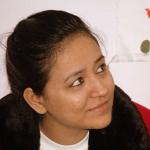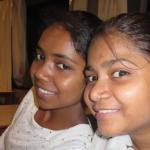Stories that the camera tells - कैमरा की कही कहानी
I was quite excited about today’s workshop. I knew the topic of today’s session but I did not know how exactly it would shape to be as everyone has a different style of teaching and explaining things. I was happy beforehand because the workshop was on a topic that I am interested in and is close to my heart and I was curious to know more about it. Today’s workshop was on documentary filmmaking and how to use a camera’s lens to tell stories in different ways by Suneet Shukla, an independent filmmaker who has studied documentary filmmaking closely.
In the beginning was an introductory round in which we learned about each other more. So far, all the photographers and documentary filmmakers that I have met ask the same question: why do you click photographs? Why do you like photography? Suneet asked us the same thing. At that time, I wondered why they all ask this every single time. Perhaps they all have this question in their minds constantly. Maybe even I will ask this question later both to myself and the students I teach. Maybe it is then that I will understand why this question is so important and features constantly. When Suneet asked us this question, most of our answers matched at some level. We saw several documentaries as the session was essentially on documenting stories through a video camera and learned intricate details associated with it.
We learned all about the story behind the making of a video shot. What I liked most about this workshop was that there was less to write and more to watch and hear. All the movies that were shown were interesting and engaging and each one of them had a memorable aspect to it. With each film, I learned different technical details around its filmmaking. For instance, someone narrating from behind as the visual story moves forward, telling the story of someone without necessarily showing his/her face, use of sounds and sometimes, how, only people’s voices add up to the entire film’s audio. Suneet also explained us how several aspects of a single story can be told in different ways using a camera’s lens. Everyone’s thought is different and a director’s role is to convey his/her thought process using the medium of a camera and ensure that it reaches more people.
When Suneet was telling us about “framing shots”, it reminded me of a lot of older things and experiences from where I began my journey as a filmmaker. I learned things from him that I have often thought about but never used in my filmmaking. I will now keep in mind how to use these in my next film. I also showed him a movie I recently made. After watching it, Suneet gave me suggestions on improving it and presenting the story better. When others told me that I had made this film using Windows Movie Maker, he was very impressed that I had managed to make an entire film with limited options for editing software.
After some time, we saw and showed the movie ‘Apna Haq’: our first movie that we made together. Every time we talk about Apna Haq, I get nostalgic and recall those fun days. That entire experience and a significant socially relevant issue was conveyed in a film of seventeen minutes. I remember all those things and the experiences. The people we spoke to; the people we even fought with. Clicking photos, understanding issues, using a camera and taking it to our communities and talking to so many people—all former memories were relived. And when someone asks about this experience, I feel amazing talking about it. I feel so much happiness that perhaps I would never be able to experience through words.
We then requested Suneet to show us a film made by him. He showed us a film that he had made during his college days. That film used humour as a powerful tool to tell a story and I found that to be something new and interesting. I really enjoyed this session as I learned how to tell stories using the camera in new and innovative ways. I hope such workshops are organized more so that I can continue my practice.
Deepika Passi is an alumni of our Tech Center. A budding photographer and filmmaker, she is currently a fellow working on using photography as a medium to convey issues around gender.
Edited and translated by Deepa Ranganathan.
आज की वर्कशॉप को लेकर मैं उत्सुक्त थी | मुझे पता था कि वर्कशॉप किस विषय पर है पर किस तरह से बताया या सिखाया जाएगा, यह नही पता था। क्योंकि सबके तरीके अलग होते हैं चीज़ों को समझने का । मैं पहले से ही खुश थी क्योंकि जिस जिस विषय में मेरी दिलचस्पी और चाहत है, आज वर्कशॉप उसी पर होने वाली थी और उसके बारे मैं और जानने को मिला । आज की वर्कशॉप डॉक्युमेंटरी फिल्ममेकिंग और कैमरा के लेंस से कहानी बताने पर सुनीत शुक्ला द्वारा आयोजित की गयी | सुनीत एक इनडिपेंडेंट डॉक्युमेंटरी फिल्ममेकर हैं जिन्होने इस विषय पर पढ़ाई भी की है |
जैसा की शुरुवात हमेशा परिचय से ही होती है, हमने भी एक दूसरे के बारे मैं जाना। मैं आज तक जितने भी फोटोग्राफी या डॉक्यूमेंट्री मूवी से जुड़े जितने भी लोगो से मिली हूँ, सब यही पूछते हैं: आप तस्वीरें क्यों खींचते हैं? आपको तस्वीरें खींचना क्यों पसंद है? और सुनीत ने भी हमसे यही पूछा । उस समय मेरे दिमाग में चल रहा था कि सभी यही सवाल क्यों पूछते हैं? शायद सबके दिमाग में यह एक ही सवाल चलता है | शायद मैं भी आगे चलकर यही सवाल खुद से और दूसरों से पूछूँ | शायद तब समझ आएगा कि इस सवाल का महत्व क्या है । जब सुनीत ने यह पूछा हम सब के जवाब कही न कही मिल रहे थे । वर्कशॉप फोटोग्राफी और डॉक्यूमेंट्री फ़िल्म मेकिंग पर हो रहे इस सेशन मेंहमने डॉक्यूमेंट्री देखी और इससे जुडी बारीक चीज़ें को समझा |
एक वीडियो शॉट बनाने के पीछे की कहानी के बारे में पता चला। इस वर्कशॉप की सबसे अच्छी चीज लिखने से ज़्यादा सुनना और देखना था और यह बात मुझे बहुत अच्छी लगी । सारी मूवीज़ दिलचस्प और रोचक थी और हर फिल्म की कोई ना कोई पहलू थी जो यादगार थी । अलग अलग फिल्म में मुझे अलग अलग बारीकियों के बारे में पता चला | जैसे पीछे से कोई हानी सुना रहा है और कहानी आगे बढ़ रही है | बगैर किसी का चेहरा दिखाए कहानी को दर्शाना । आवाज़ों का इस्तेमाल और किस तरह कभी कभी सिर्फ़ लोगों की बातें ही पूरी फिल्म की आवाज़ बन जाती हैं | सुनीत ने यह भी बताया कि किसी भी कहानी और उसके अलग अलग पहलू को हम किस तरह से कैमरा की लेंस से बता सकते हैं और फिल्म के द्वारा लोगों तक पहुँचा सकते हैं | हर किसी की सोच अलग होती है और एक निर्माता की यही भूमिका होती है कि वह अपनी सोच को किस तरह पर्दे पर दिखा सके कि देखने वालों तक वह सोच पहुँच सके |
सुनीत जब हमें ‘फ्रेमिंग शॉट्स’ के बारे में बता रहे थे तो मुझे बहुत सी पुरानी चीज़ें और अनुभव की याद आ गयी जहाँ से मैने शुरुवात की थी। उनसे कुछ ऐसी चीज़ें सुनने को मिली जिनके बारे में मैं अक्सर सोचती हूँ | किस तरह इन्हे मैं अपनी फिल्मों में इस्तेमाल कर सकती हूँ, अब मैं यह ध्यान में रखूँगी । मैंने उन्हें अपनी बनाई हुई एक मूवी भी दिखाई जो । उन्हे देखकर सुनीत ने मुझे उसे और बेहतर बनाने के कुछ उपयोगी सुझाव दिए । जब सबने बताया की ये मूवी विंडोस मूवी मेकर पर बनाई गयी है तो उन्हें सुन कर बहुत अच्छा लगा कि कम सॉफ्टवेर और सीमित विकल्प में मैने एक पूरी फिल्म इतनी अच्छी बनाई ।
कुछ देर बाद हमने अपना हक़ मूवी देखी और दिखाई: हमारी पहली मूवी जो हम सब ने मिलकर बनाई थी | जब अपना हक़ मूवी की बात आती है तो वो समय याद आ जाता है जब हमने इस फिल्म को बनाया और कितने मज़े किए | उस पूरे अनुभव और एक एहम मुद्दे को हमने एक सत्रह मिनिट की फिल्म में कैद किया था | वो चीज़ें याद आई जो उस समय हमने देखी और महसूस की । वो लोग याद आए जिनसे हमने बाते की | एक दो बार हमने लड़ाई भी कर डाली थी | तस्वीरें खींचना, मुद्दों को समझना, कैमेरा लेकर अपने समुदाय में जाना और लोगो से बातें करना—सारी पुरानी यादें ताज़ा हो जाती हैं | और इसके बारे में जब कोई पूछता है तो और भी अच्छा लगता है बताने में । एक ऐसी खुशी महसूस होती है जो शायद मैं कभी शब्दों में नही बता सकती ।
सुनीत से हमने अनुरोध किया कि वो अपनी बनाई हुई कोई फिल्म हमें दिखाए | उन्होने हमे एक फिल्म दिखाई जो उन्होने अपने कॉलेज के दिनों में बनाई थी | उस फिल्म में कहानी को व्यंग्य के सहारे बताया था और यह मुझे एक नयी चीज़ लगी | इस वर्कशॉप में मुझे बहुत मज़ा आया क्योंकि मैने कहानी को फिल्म के माध्यम में बताने के काई नये तरीके सीखे | मैं चाहती हूँ कि इस तरह की वर्कशॉप और हों ताकि मेरी अभ्यास जारी रहे |




